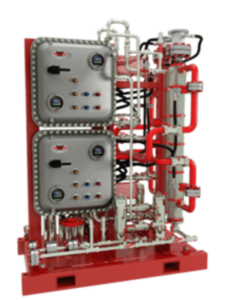Choosing Steam Pressure Systems: When to Use Low Versus High
Last updated on November 2nd, 2022 at 03:58 pm
Steam pressure systems serve various applications in various industries. Of course, different steam heating systems operate with varying pressure levels, and it’s important to know what system best suits your operation. This post will explain the differences between low and high-pressure systems and which ones are most suitable for particular purposes.
Low versus high-pressure steam systems: 101 primer
 The obvious difference between low and high-pressure systems is the amount of pressure on which they operate. Low-pressure systems produce no more than 15 pounds per square inch (psi) and don’t heat water beyond 250ºF.
The obvious difference between low and high-pressure systems is the amount of pressure on which they operate. Low-pressure systems produce no more than 15 pounds per square inch (psi) and don’t heat water beyond 250ºF.
Contrarily, high-pressure steam systems generate steam above 15 psi. In some cases, these levels can reach hundreds of psi and can heat water to far exceed temperatures far greater than 250ºF. Although any steam pressure system that operates above 15 psi could be considered a “high-pressure” system, most tend to run at or above 75 psi.
However, the differences don’t end here since low and high-pressure systems work better for some applications than others.
When to use low-pressure steam heating systems
Steam pressure systems on the lower end are the more economical boilers for various applications. Because they produce lower pressure levels, they use less energy which translates to lower energy costs. Also, their reduced energy consumption means they don’t develop wear-and-tear as quickly as high-pressure steam heating systems.
Steam pressure systems on the low end of the spectrum are ideal for providing hot water to residential and commercial facilities.
Ideal uses for steam pressure systems with low settings
- Hospitals
- University campuses
- Office buildings
- Multi-family dwellings
Low-pressure steam systems can occasionally service more demanding industrial processes. However, these tend to be smaller-scale operations that don’t require great temperatures or pressure. They include food processing plants (for pasteurization), micro-distileries, laboratories and lumber mills.
When to use high-pressure steam systems
High-pressure steam heating systems have considerable advantages over low-pressure ones for servicing heavy-duty applications. The substantial pressure and temperature at which they operate allow them to support industrial processes requiring significant energy transfers.
Typical uses for high-pressure steam systems
- Manufacturing of consumer goods
- Rubber vulcanizing
- Oil and petrochemical applications
- Transportation (steam engines)
The main advantage of high-pressure steam systems is that they supply continuous energy. A constant supply of energy is vital for heavy-duty applications.
Wattco steam pressure systems and recommendations
A general rule of thumb is that the greater the energy demands of an application, the more pressure you’ll require from your steam heating system. These applications usually involve heating liquids or gases to extraordinary temperatures. On the other hand, applications that don’t need such demands can benefit from steam pressure systems that produce lower pressure (and temperature) settings.
Of course, the ideal steam pressure system for your industrial operation can fall in a grey area. Our Wattco representatives work alongside a team of engineers and scientists to ensure that you choose the right steam pressure system for your application. With their expertise, you can find a custom steam solution to meet the demands of your industry. Get a quote or request more information about a steam pressure system today.
